What if I told you that just 8% of your customers could generate 41% of your revenue? You’d probably want to know how to identify, nurture, and multiply those customers. That’s exactly what loyalty programs do. They transform casual browsers into devoted fans and occasional shoppers into reliable revenue.
In the increasingly competitive Shopify ecosystem, where stores fight for every click and conversion, customer retention isn’t just nice to have—it’s essential for survival. Loyalty programs offer a strategic advantage that impacts everything from your bottom line to your brand’s community strength.
The numbers tell a compelling story. Acquiring a new customer costs 5-25 times more than retaining an existing one. Meanwhile, increasing customer retention by just 5% can boost profits by 25-95%. These aren’t just statistics—they’re a wake-up call for every Shopify store owner still pouring their entire budget into acquisition while neglecting retention.
In this comprehensive guide, we’ll walk through everything you need to know about creating, implementing, and optimizing a loyalty program that works specifically for your Shopify store. You’ll discover how to choose the right program type, set up the technical aspects, launch effectively, and continuously improve your strategy for maximum impact.
The Business Case for Loyalty Programs
The economics of customer retention present an irresistible case for loyalty programs. Your repeat customers—those who’ve purchased at least twice—make up a relatively small percentage of your customer base but contribute disproportionately to your revenue. They know your brand, trust your products, and require less convincing to make a purchase.
Consider this: it typically costs about 5-25 times more to acquire a new customer than to retain an existing one. For Shopify stores operating on tight margins, this difference is substantial. When you invest in customer retention through loyalty programs, you’re essentially buying revenue at a discount.
Beyond pure economics, loyalty programs also create competitive differentiation. Over 70% of consumers are more likely to recommend and do business with brands that have good loyalty programs. In a sea of similar Shopify stores selling comparable products, your loyalty program can be the tiebreaker that sways purchase decisions in your favor.
Loyalty Program Impact on Shopify Businesses
The benefits of well-executed loyalty programs extend far beyond just keeping customers around.
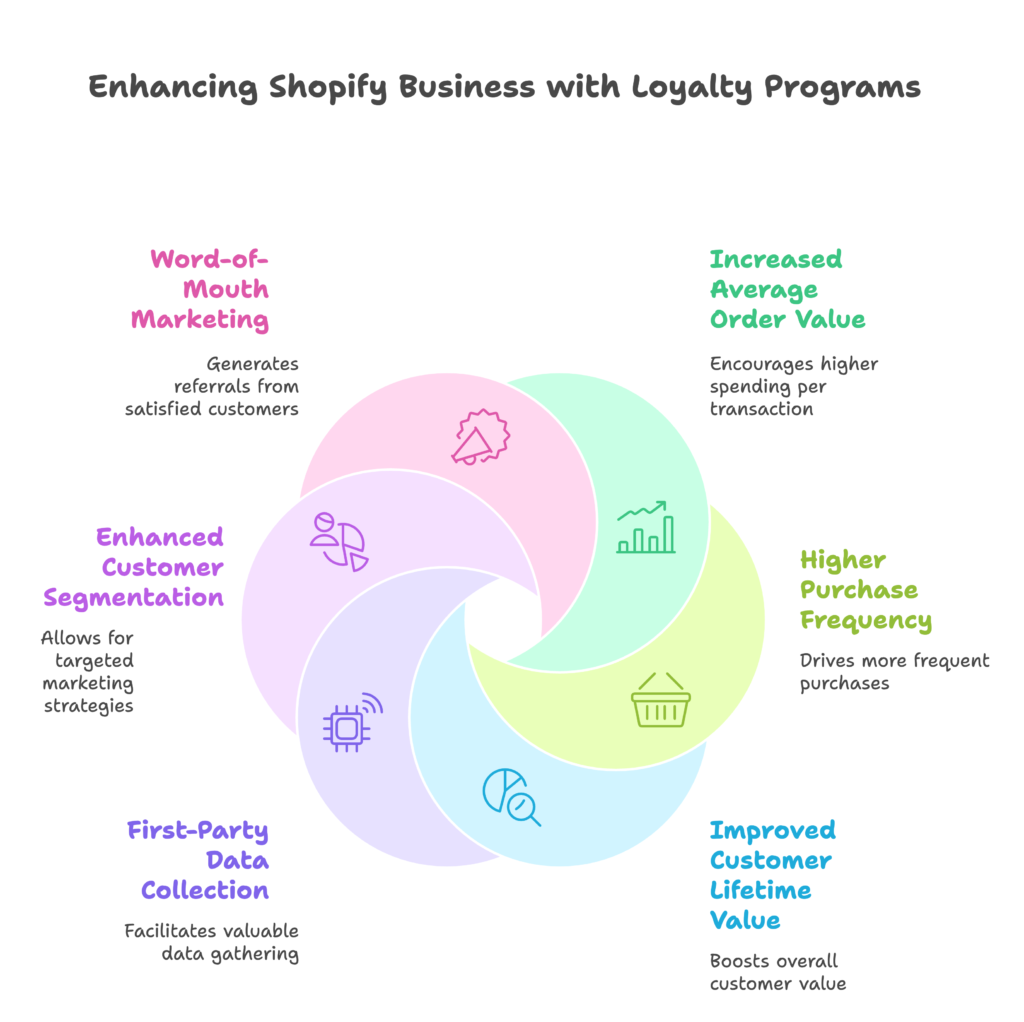
They transform your entire business model and marketing approach in several key ways:
- Increased Average Order Value: Loyalty program members typically spend 12-18% more per order than non-members. When customers see themselves closing in on a reward threshold, they’re often willing to add a few more items to their cart.
- Higher Purchase Frequency: Program members buy 29% more often than non-members. Regular rewards and point expiration deadlines create urgency that drives repeat purchases.
- Improved Customer Lifetime Value: By combining higher spend and increased frequency, loyalty programs can boost customer lifetime value by 30% or more.
On the marketing front, loyalty programs deliver equally impressive advantages. They create natural opportunities to collect valuable first-party data—which is increasingly precious in a privacy-conscious digital world. This data enables enhanced customer segmentation for more targeted marketing. And perhaps most valuable of all, loyalty programs generate word-of-mouth marketing and referrals from your most satisfied customers.
Understanding Loyalty Program Fundamentals
A loyalty program is more than just a points system or a discount scheme. It’s a strategic framework that formalizes how you recognize, reward, and build relationships with your customers. Before diving into the specifics of implementation, let’s establish a solid understanding of what makes these programs tick in the Shopify context.
Defining Loyalty Programs in the Shopify Context
At its core, a loyalty program is a structured initiative that rewards customers for specific behaviors that benefit your business. These behaviors typically include purchases, but can extend to social shares, reviews, referrals, and other forms of engagement. The most effective programs strike a careful balance between business objectives (increasing revenue and customer lifetime value) and customer desires (meaningful rewards and recognition).
What separates a true loyalty program from occasional promotions is its systematic nature. Customers understand exactly what they need to do to earn rewards, and they can see their progress toward various milestones. This transparency creates a sense of fairness and builds trust with your audience.
For Shopify store owners specifically, loyalty programs need to integrate seamlessly with the existing store infrastructure. This might include connecting with your theme, email marketing platform, and other apps in your tech stack. Thankfully, Shopify’s app ecosystem makes this integration relatively straightforward compared to other e-commerce platforms.
Every successful loyalty program, regardless of type, contains several key components:
- Reward Structures and Incentives: The specific benefits members receive (discounts, free products, exclusive access, etc.) and how they earn them
- Enrollment and Participation Mechanisms: How customers join and interact with the program
- Program Branding and Communication: How you present and explain the program to customers
- Data Collection and Analysis Systems: How you track participation and measure results
Types of Loyalty Programs for Shopify Stores
While loyalty programs can take countless forms, there are four primary types that work particularly well for Shopify stores. Each has distinct advantages and is suited to different business models and customer bases.
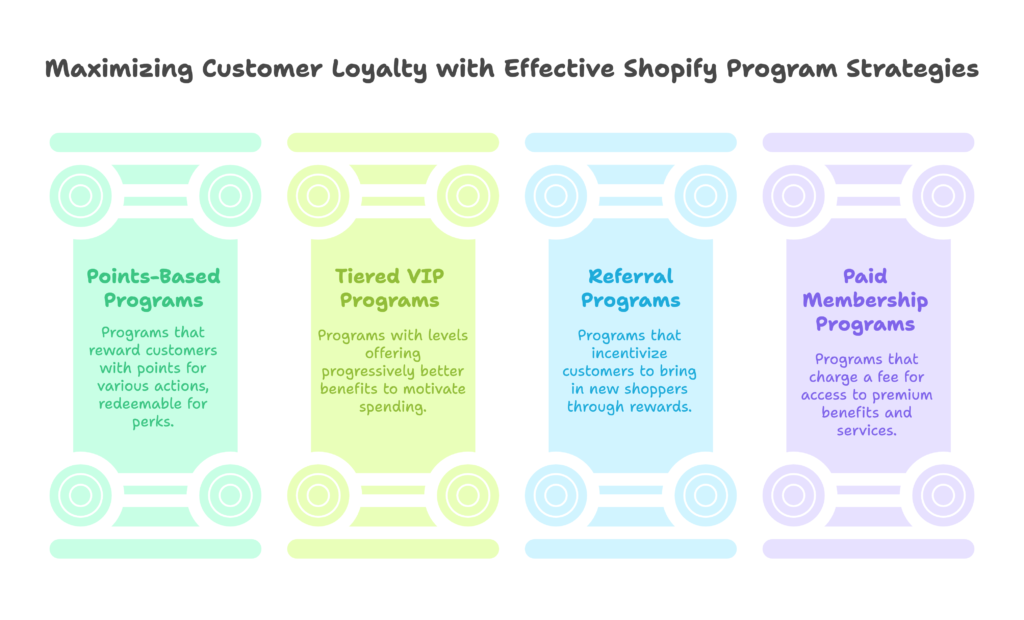
1. Points-Based Programs
The most common format, points-based programs reward customers with points for specific actions, which can later be redeemed for discounts, free products, or other perks. They’re highly flexible and can accommodate almost any reward structure.
Customers might earn points through purchases (e.g., 10 points per $1 spent), engagement actions (writing reviews, following on social media), or milestone achievements (birthday bonuses, anniversary rewards). The key is creating a clear value exchange where customers understand what their points are worth.
For Shopify implementation, numerous apps like Smile.io and LoyaltyLion offer ready-to-use points program infrastructure. These platforms handle point tracking, redemption options, and customer communication with minimal technical setup.
2. Tiered VIP Programs
Tiered programs create different membership levels (such as Silver, Gold, Platinum) with progressively better benefits at each tier. They excel at motivating customer progression and creating aspirational targets that drive increased spending.
The mechanics typically involve qualification thresholds based on spend, purchase frequency, or point accumulation. Each tier offers exclusive benefits not available to lower levels, creating a sense of status and recognition for your best customers.
What makes tiered programs particularly effective is their ability to create both short-term motivation (reaching the next tier) and long-term loyalty (maintaining status). The key challenge is balancing accessibility (making tiers achievable) with exclusivity (ensuring top tiers remain special).
3. Referral Programs
Referral programs reward existing customers for bringing new shoppers to your store. They leverage the trust and enthusiasm of your current customer base to drive acquisition while simultaneously strengthening retention.
The most effective referral programs use dual-sided rewards, benefiting both the referrer and the new customer. For example, “Give 15% off, get $10” creates incentives for both parties. This approach boosts both sharing and conversion rates.
While technically a distinct strategy, referral programs integrate naturally with broader loyalty initiatives. Many Shopify loyalty apps include referral features, allowing you to award points or status for successful referrals.
4. Paid Membership Programs
Paid membership programs flip the traditional loyalty model by charging customers for program access. In exchange, members receive premium benefits that deliver clear value beyond the membership cost.
These benefits might include free shipping on all orders, automatic discounts, exclusive products, or early access to sales. The membership fee creates immediate revenue while filtering for your most committed customers.
Amazon Prime represents the gold standard for this model, but even small Shopify stores can implement effective paid programs. The key is ensuring the benefits significantly outweigh the membership cost from the customer’s perspective.
Planning Your Shopify Loyalty Program Strategy
Before jumping into implementation, you need a clear strategy that aligns your loyalty program with your business goals and customer needs. This planning phase will prevent costly missteps and ensure your program delivers the results you want.
Setting Clear Objectives
Every successful loyalty program starts with well-defined objectives. These goals serve as your north star, guiding decisions about program structure, rewards, and communication.
Begin by identifying your primary and secondary business objectives. Common goals include:
- Increasing purchase frequency
- Boosting average order value
- Reducing churn rates
- Encouraging specific customer behaviors (reviews, social sharing)
- Collecting more customer data
- Differentiating from competitors
For each objective, establish measurable KPIs that will help you track progress. If your goal is increasing purchase frequency, for example, you might track the average days between purchases for program members versus non-members.
Your objectives should also align with your broader business strategy. A premium brand focusing on exclusivity might prioritize a tiered VIP program, while a high-volume seller might benefit more from a points-based system that rewards frequent purchases.
Customer insights should play a crucial role in your objective-setting process. Use your existing data to understand current purchase patterns, analyze customer feedback for pain points and desires, and research what competitors offer in their loyalty programs.
Customer Segmentation for Targeted Programs
Not all customers engage with loyalty programs in the same way. By segmenting your customer base, you can create more targeted strategies that address different motivations and behaviors.
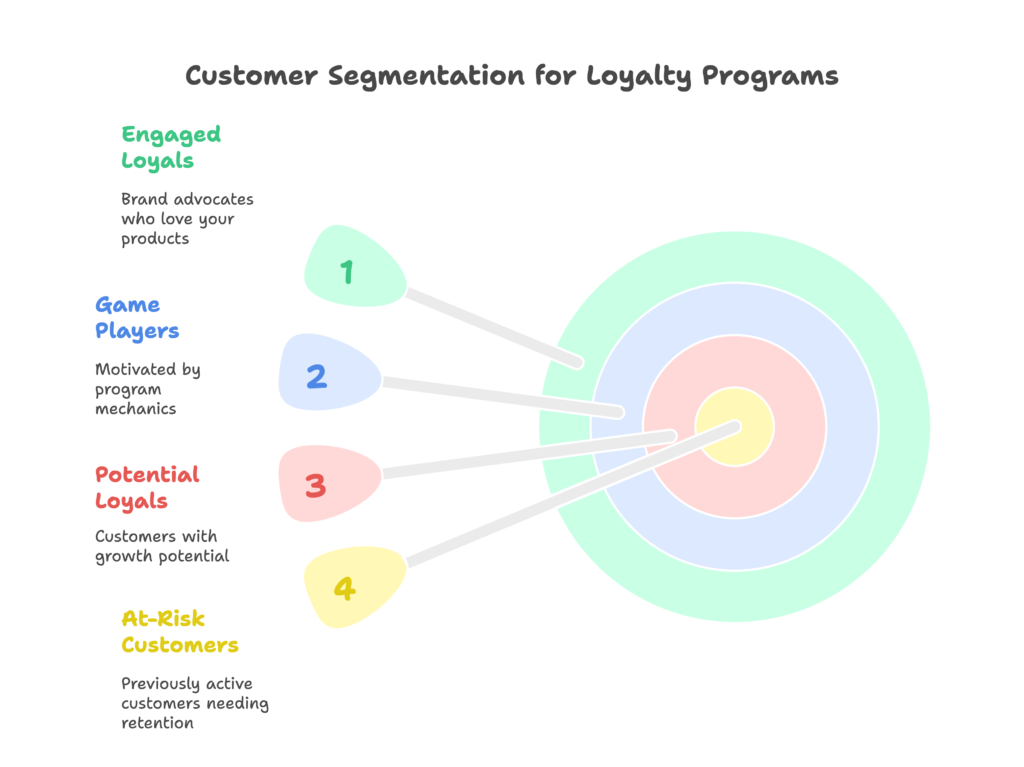
Consider dividing your customers into these four key segments:
- Engaged Loyals: These brand enthusiasts and advocates already love your products and shop frequently. They’re likely to become program champions and spread the word.
- Game Players: These customers are specifically motivated by program mechanics like point collection and status achievement. They respond well to gamification elements.
- Potential Loyals: These customers have made a few purchases but haven’t fully committed to your brand. They have significant growth potential with the right incentives.
- At-Risk Customers: These previously active customers have shown declining engagement or haven’t purchased recently. They require specific retention interventions.
Each segment requires a tailored approach. Engaged loyals might respond best to exclusive experiences and recognition, while game players appreciate clear progress tracking and achievement markers. Potential loyals often need value-focused incentives that demonstrate the benefits of commitment, and at-risk segments typically require stronger win-back offers.
Resource Planning and Allocation
Loyalty programs require ongoing investment of both financial and human resources. Proper planning ensures your program remains sustainable and delivers positive ROI.
Your budget should account for several categories of expenses:
- Program Development Costs: App subscriptions, custom development, design work
- Ongoing Reward Fulfillment: The actual cost of discounts, free products, or special experiences
- Marketing and Promotion: Resources needed to promote the program and drive enrollment
For reward costs specifically, calculate the expected redemption rate and average reward value to estimate monthly expenses. Many loyalty experts recommend allocating 1-3% of customer-generated revenue back into loyalty rewards.
On the human resources side, clarify who will be responsible for program management, customer service inquiries related to the program, marketing communications, and technical support. Even with automated systems, loyalty programs require regular oversight and optimization.
Implementing Loyalty Programs on Shopify
With your strategy defined, it’s time to bring your loyalty program to life on your Shopify store. The implementation phase involves selecting the right app, configuring program rules, and integrating with your broader Shopify ecosystem.
Selecting the Right Loyalty App
The Shopify App Store offers numerous loyalty solutions, but they vary significantly in features, complexity, and cost. Finding the right fit for your specific needs is crucial.
When evaluating loyalty apps, consider these key criteria:
- Feature Alignment: Does the app support the specific program type and features you’ve planned?
- Integration Capabilities: Does it work well with your theme, email platform, and other critical apps?
- Scalability: Can it grow with your business without becoming prohibitively expensive?
- Pricing Structure: Does the cost structure make sense for your business size and expected program engagement?
Some popular Shopify loyalty apps to consider include:
- Essential VIP Loyalty Program: Great for stores that want to start with a simple, cost-effective points program. It offers easy setup and core functionality like points for purchases, referrals, and social actions.
- Smile.io: A comprehensive solution that supports points, VIP tiers, and referral programs. It’s known for clean widget design and excellent Shopify integration.
- LoyaltyLion: A powerful platform with advanced segmentation, automation, and analytics. Best for stores ready to invest in a sophisticated loyalty strategy.
- Yotpo: Offers loyalty features as part of a broader customer content platform that includes reviews and visual marketing.
Most apps offer free trials, which you should absolutely use to test functionality before committing. Create test customer accounts and run through the entire loyalty experience from enrollment to reward redemption.
Technical Setup and Configuration
Once you’ve selected an app, you’ll need to configure it according to your program strategy. The specific steps will vary by platform, but generally include:
1. App Installation
Install the app from the Shopify App Store and follow the initial setup wizard. This typically involves granting necessary permissions and connecting your store account.
If possible, install the app on a development store or test environment first to avoid disrupting your live store during configuration. Most loyalty apps also offer a “hidden” mode where the program is only visible to you until you’re ready to launch.
2. Program Rules Configuration
This is where your program strategy comes to life through specific rules and settings:
- Point Values and Earning Rules: Define how many points customers earn per dollar spent, for social actions, or for other behaviors. Aim for simplicity and clear value (e.g., “10 points = $1” is easier to understand than “27 points = $1.35”).
- Reward Options: Configure what customers can redeem their points for, whether that’s percentage discounts, fixed amount discounts, free products, or special perks.
- Tier Thresholds and Benefits: If using a tiered program, set qualification thresholds for each level and define the exclusive benefits that apply.
- Referral Mechanisms: Set up tracking links, referral rewards, and new customer incentives if implementing a referral component.
Many apps also allow for program rules customization based on customer segments, product categories, or other variables. While these advanced features can create highly targeted experiences, start with a simpler structure you can refine over time.
3. Design and Branding Implementation
Your loyalty program should feel like a natural extension of your brand, not a third-party add-on. Most apps allow customization of:
- Loyalty Widgets and Displays: Customize colors, fonts, and imagery to match your store’s aesthetic.
- Program Naming and Terminology: Create branded language for points (Stars, Coins, Credits) and membership tiers.
- Email Templates: Design program-related emails that maintain your brand identity.
Pay special attention to mobile optimization, as many customers will interact with your loyalty program on smartphones. Test the full experience on various devices to ensure responsive design and easy interaction.
Integration with Shopify Ecosystem
Your loyalty program doesn’t exist in isolation—it needs to connect with other elements of your Shopify store for maximum effectiveness.
1. Store Theme Integration
Determine where loyalty program elements will appear within your store interface:
- Widget Placement: Common locations include the header, footer, floating tab, or account page. Consider visibility versus intrusiveness.
- Program Pages: Create dedicated pages explaining program details, accessible from your main navigation.
- Checkout Integration: Ensure point earning and redemption options are clearly visible during checkout.
User experience should be paramount in these decisions. The program should be easily discoverable without disrupting the shopping experience.
2. Email Marketing Platform Connections
Connect your loyalty app with your email marketing platform (like Klaviyo or Omnisend) to enable:
- Automated welcome emails for new program members
- Point balance updates and reward availability notifications
- VIP tier achievement congratulations
- Re-engagement campaigns for inactive members
These integrations allow for sophisticated segmentation and targeted messaging based on loyalty status and behavior.
3. Analytics Setup
Configure tracking and reporting to measure program performance:
- Set up custom reports for key metrics like enrollment rates, point accumulation, and redemption patterns
- Create dashboards for easy monitoring of program health
- Establish regular review cadences to analyze performance data
Consider implementing UTM parameters for loyalty-related links to track how the program influences shopping behavior and conversion rates.
Launching and Promoting Your Loyalty Program
Even the most perfectly designed loyalty program won’t deliver results if customers don’t know about it or understand its value. A strategic launch and ongoing promotion are essential for driving enrollment and engagement.
Launch Strategy Development
Before making your program visible to customers, ensure you’re fully prepared for rollout.
1. Pre-Launch Preparation
Complete these critical steps before going live:
- Staff Training: Ensure everyone on your team understands how the program works and can answer customer questions. Create an internal FAQ document for reference.
- Educational Content: Develop clear explanations of program mechanics, benefits, and enrollment processes. This might include dedicated program pages, video tutorials, or infographics.
- Technical Testing: Rigorously test every aspect of the program, from point earning to reward redemption, using test accounts and transactions.
Many stores benefit from a “soft launch” approach where they quietly activate the program for a small group of customers or staff members. This allows you to identify and fix any issues before full-scale announcement.
2. Launch Timing and Phasing
Consider strategic timing for your program launch:
- Seasonal Factors: Launching during your peak season provides maximum visibility but might create implementation challenges. Quieter periods allow for more controlled rollout but might require stronger promotion.
- Business Cycle Alignment: Coordinate with other marketing initiatives, product launches, or website updates.
- Phased Implementation: Consider starting with core features and expanding the program over time as you gather feedback and data.
For significant launches, create a detailed timeline covering pre-launch preparation, launch day activities, and post-launch follow-up actions.
Promotion Tactics
Once your program is live, you need a multi-channel promotion strategy to drive awareness and enrollment.
1. On-Site Promotion
Your store itself is the primary channel for promoting your loyalty program:
- Homepage Banner: Feature the program prominently in your hero section or announcement bar.
- Strategic Widget Placement: Position loyalty widgets where they’ll capture attention without disrupting shopping.
- Checkout Integration: Highlight potential point earnings during checkout to incentivize both program enrollment and purchase completion.
- Account Page Promotion: Prominently feature enrollment options and program benefits in customer account sections.
For maximum impact, combine persistent program visibility (like navigation menu links or floating tabs) with limited-time promotional elements (like homepage takeovers or special launch offers).
2. Email Marketing Campaigns
Email remains one of the most effective channels for loyalty program promotion:
- Announcement Sequence: Create a series of emails introducing the program, explaining benefits, and addressing common questions.
- Segmented Messaging: Tailor program announcements based on customer behavior and purchase history. High-value customers might receive messaging focused on exclusive VIP benefits, while occasional shoppers might respond better to immediate reward opportunities.
- Educational Content Series: Follow initial announcements with helpful content about maximizing program benefits.
Consider offering special incentives for early enrollment, such as bonus points or exclusive launch rewards, to create urgency and drive immediate participation.
3. Social Media Strategies
Social platforms offer unique opportunities for program promotion:
- Platform-Specific Announcements: Adapt your messaging and creative assets for each social channel’s audience and format.
- Member Spotlights: Feature early adopters and showcase their rewards or experiences.
- Exclusive Social Promotions: Create special offers available only to your social audience to drive both program enrollment and social following.
If your loyalty program includes social engagement rewards (points for follows, shares, etc.), make these opportunities especially visible in your social promotion strategy.
4. Paid Advertising Considerations
While organic promotion should be your foundation, paid advertising can accelerate program adoption:
- Retargeting Existing Customers: Create ads specifically for people who have previously purchased but haven’t enrolled in your loyalty program.
- Loyalty as Value Proposition: Incorporate program benefits into acquisition ads to differentiate your store from competitors.
- Specific Campaign Budgets: Allocate dedicated advertising funds for program promotion, especially during the launch phase.
The ROI on loyalty-focused advertising tends to be higher than general acquisition advertising because you’re targeting people already familiar with your brand.
Managing and Optimizing Your Loyalty Program
A loyalty program isn’t a “set it and forget it” initiative. Ongoing management and continuous optimization are essential for long-term success and positive ROI.
Performance Monitoring
Rigorous tracking and analysis help you understand what’s working and what needs improvement.
1. Key Metrics to Track
Focus on these critical performance indicators:
- Enrollment and Participation Rates: What percentage of customers join the program? How many actively engage with it?
- Point Accumulation and Redemption: How quickly do members earn points? What percentage of available points are redeemed?
- Program Impact Metrics: How do program members compare to non-members in terms of average order value, purchase frequency, and retention rates?
- Economic Measures: What’s the program’s overall ROI? What’s the average cost per redemption?
For each metric, establish benchmarks based on industry standards and your own historical data. This provides context for evaluating performance and setting improvement goals.
2. Reporting and Analysis
Develop a structured approach to program analysis:
- Regular Review Cadence: Schedule weekly quick-checks of basic metrics and monthly deep-dives into comprehensive performance.
- Segment-Specific Analysis: Break down performance data by customer segments, acquisition sources, or product categories to identify patterns.
- Comparative Evaluation: Compare current performance to historical data, industry benchmarks, and your original program goals.
Look beyond surface-level metrics to understand underlying causes. For example, if redemption rates are low, investigate whether the issue is point values, reward appeal, redemption process complexity, or communication effectiveness.
Program Refinement Strategies
Use your analysis insights to continuously improve your loyalty program’s effectiveness.
1. Test and Learn Approach
Implement controlled experiments to optimize program elements:
- A/B Testing Reward Structures: Test different reward options to see which drives higher engagement and redemption.
- Point Value Experimentation: Adjust point earning rates or redemption thresholds to find the optimal balance between member satisfaction and program economics.
- Communication Testing: Try different messaging approaches, frequencies, and channels to maximize program understanding and participation.
Establish clear success metrics for each test and allow sufficient time for statistically significant results before making permanent changes.
2. Member Feedback Integration
Your program members are a valuable source of improvement insights:
- Satisfaction Surveys: Gather structured feedback on program elements and overall experience.
- Customer Suggestions: Create channels for members to submit ideas for program enhancements.
- Complaint Analysis: Closely monitor and categorize program-related support tickets to identify friction points.
When implementing changes based on member feedback, communicate that you’re responding to their input. This creates a positive feedback loop and strengthens loyalty by demonstrating that you value their opinions.
Addressing Common Challenges
Even well-designed loyalty programs encounter typical obstacles that require specific solutions.
1. Low Engagement Solutions
If program participation is lower than expected, consider these adjustments:
- Simplify Complex Rules: Reduce confusion by streamlining program mechanics and creating clearer explanations.
- Enhance Reward Value Perception: Improve how you communicate the dollar value of points or emphasize exclusive experiences that money can’t buy.
- Increase Program Visibility: Make loyalty elements more prominent throughout the customer journey.
- Create Short-Term Wins: Offer smaller, more immediate rewards alongside larger redemption options to provide quicker gratification.
Sometimes engagement issues stem from poor onboarding. Consider creating a dedicated welcome sequence that guides new members through their first program interactions.
2. Technical Issue Management
Technical problems can quickly undermine program credibility:
- Point Tracking Problems: Regularly audit point transactions to ensure accurate crediting and investigate discrepancies promptly.
- Redemption Difficulties: Test the redemption process frequently and streamline checkout integration.
- Integration Failures: Monitor connections between your loyalty app and other systems, especially after updates to any part of your tech stack.
Establish clear protocols for handling technical issues, including compensation policies for members affected by errors. Swift, generous resolution of technical problems can actually strengthen loyalty when handled properly.
3. Program Economics Optimization
If your program costs are outpacing benefits, consider these adjustments:
- Reward Value Calibration: Adjust point values or redemption rates to ensure sustainable program economics without drastically reducing perceived value.
- Spending Thresholds: Implement minimum purchase requirements for reward redemption to improve margin protection.
- Premium Reward Shifts: Focus high-value rewards on behaviors that directly drive profitability, like larger orders or full-price purchases.
Remember that program economics should be evaluated over customer lifetime, not just single transactions. What might look expensive per transaction often pays off through increased lifetime value.
Advanced Loyalty Strategies for Shopify Stores
Once you’ve mastered the fundamentals and have a well-functioning program, you can explore more sophisticated loyalty strategies that create deeper engagement and differentiation.
Personalization and Customization
Generic, one-size-fits-all loyalty programs are giving way to highly personalized experiences that resonate with individual preferences and behaviors.
1. Individualized Rewards
Move beyond standard rewards to offers tailored to specific customers:
- Purchase History-Based Recommendations: Offer rewards related to categories or products a customer has previously purchased.
- Preference-Driven Incentives: Allow members to indicate reward preferences or create wishlists that guide your offers.
- Behavior-Triggered Special Offers: Automatically generate customized rewards based on browsing patterns, cart abandonment, or seasonal purchasing behavior.
Many advanced loyalty apps now incorporate machine learning algorithms that can predict which rewards will most appeal to individual members based on their unique interaction patterns.
2. Dynamic Program Experiences
Create program journeys that adapt to member engagement levels:
- Customized Loyalty Journeys: Develop different program paths for different customer segments, focusing on relevant behaviors and rewards.
- Adaptive Reward Options: Automatically adjust available rewards based on engagement patterns and preferences.
- Personalized Milestone Celebrations: Create special recognition moments for individual achievements like anniversary of program enrollment or reaching point thresholds.
The key to effective personalization is making it feel natural and relevant rather than creepy or intrusive. Focus on using data to enhance the customer experience, not just to maximize short-term conversions.
Omnichannel Loyalty Integration
If you operate both online and physical retail locations, creating a seamless loyalty experience across all channels is essential.
1. In-Store and Online Synchronization
Eliminate friction between channels with these strategies:
- Unified Point Accumulation: Ensure customers can earn and redeem points regardless of where they shop.
- Consistent Recognition: Train in-store staff to acknowledge loyalty status and provide appropriate VIP treatment.
- Cross-Channel Visibility: Give customers and staff access to complete loyalty information, including point balances and available rewards, across all channels.
Consider implementing digital loyalty cards (through mobile wallet integration or dedicated apps) to facilitate smooth in-store identification and reward processing.
2. Mobile App Integration
If you have a dedicated mobile app for your Shopify store, make loyalty a central feature:
- Prominent Loyalty Dashboard: Create an easily accessible hub for members to track status, points, and rewards.
- Push Notification Strategies: Use targeted alerts for point balance updates, reward availability, or exclusive offers.
- Mobile-Specific Features: Develop loyalty experiences uniquely suited to mobile, such as location-based rewards or QR code scanning for in-store points.
Even without a dedicated app, ensure your loyalty program is fully mobile-optimized through responsive design and mobile wallet compatibility.
Community Building Through Loyalty
The most powerful loyalty programs transcend transactional relationships to foster genuine community and emotional connection with your brand.
1. Exclusive Member Experiences
Create special opportunities that money alone can’t buy:
- VIP Events: Host virtual or in-person gatherings for program members, such as product launches, workshops, or Q&A sessions with your team.
- Early Access: Give members first opportunity to shop new collections, use new features, or access limited-edition products.
- Behind-the-Scenes Access: Share insider content about your brand story, product development, or company culture exclusively with loyalty members.
These experiences create emotional bonds that are much harder for competitors to replicate than simple discounts or points.
2. User-Generated Content Integration
Transform members from passive participants to active brand advocates:
- Rewarding Content Creation: Offer points or special recognition for reviews, social sharing, or user-generated content featuring your products.
- Advocacy Incentives: Create specific rewards for members who refer friends or promote your brand organically.
- Member Spotlights: Feature loyal customers in your marketing, sharing their stories and experiences with your products.
This approach not only strengthens individual loyalty but creates a virtuous cycle where community members inspire and influence each other.
References
- Essential VIP Loyalty Program. (2025). Shopify App Store. https://apps.shopify.com/essential-loyalty-rewards-program
- Build with Toki. (2023). Implementing and Managing a Shopify Loyalty Card Program. https://www.buildwithtoki.com/blog-post/shopify-loyalty-card
- Ecorn Agency. (2024). Shopify Loyalty Programs: A Strategic Guide to Customer Retention. https://www.ecorn.agency/blog/shopify-loyalty-programs-strategic-guide-customer-retention
- Orichi eCommerce. (2024). Shopify Loyalty Program Ideas to Boost Retention. https://orichi.info/2024/12/05/shopify-loyalty-program-ideas/
- Shopify. (2025). What Is a Loyalty Program? 4 Best Examples. https://www.shopify.com/blog/loyalty-program
Ready to supercharge your Shopify store’s sales with perfectly optimized discount codes and loyalty campaigns? Growth Suite is a Shopify app that helps you run effective on-site discount and email collection campaigns. Its powerful data engine analyzes customer behavior to deliver personalized offers at exactly the right moment. Install it with a single click and start transforming casual browsers into loyal customers!
Also don’t forget to check these articles;
The Complete Guide to Setting Up Your First Shopify Loyalty Program
Loyalty Program Psychology: Understanding What Truly Motivates Your Shopify Customers
Points vs. Tiers vs. VIP: Choosing the Right Loyalty Structure for Your Shopify Store
Loyalty Program Metrics That Matter: Measuring the Success of Your Shopify Rewards
Common Loyalty Program Mistakes Shopify Store Owners Make (And How to Avoid Them)
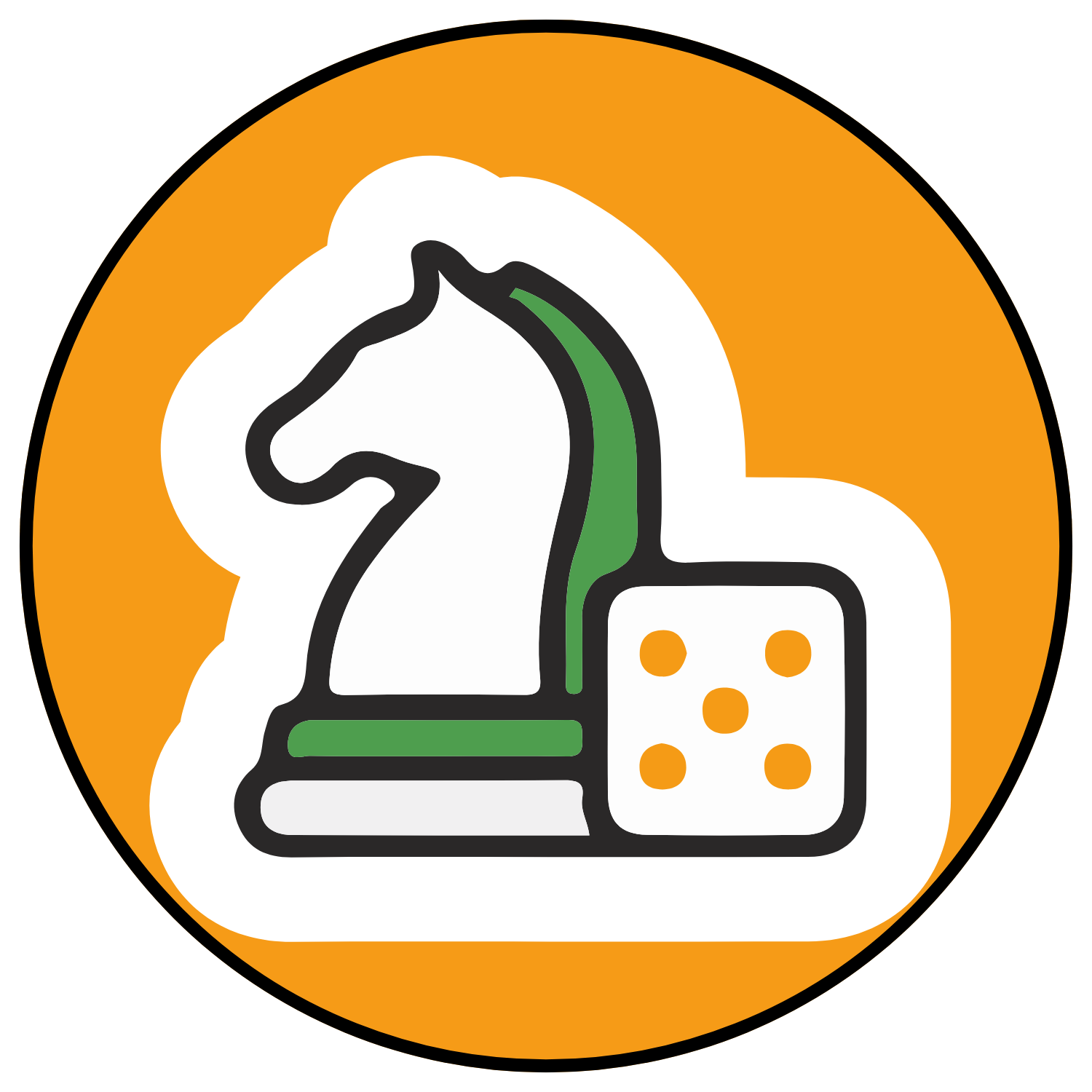
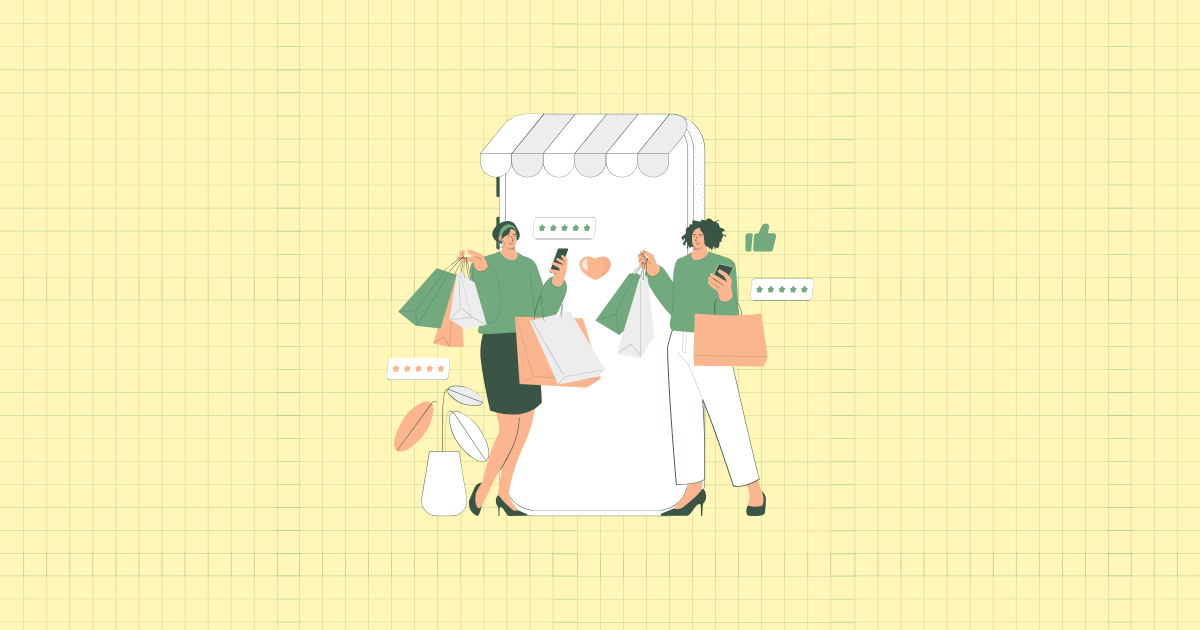


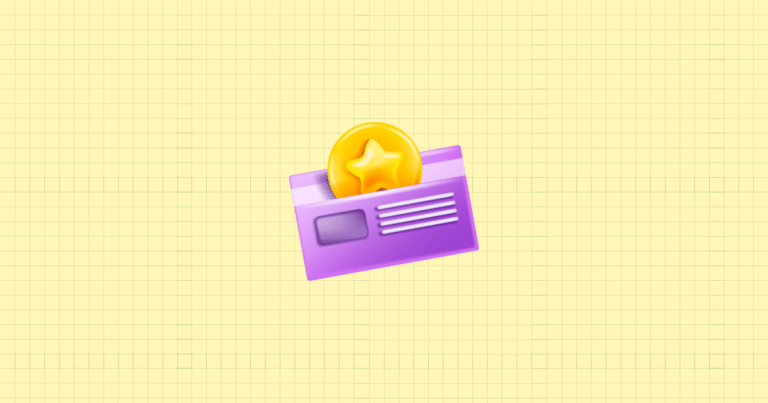
[…] Shopify Loyalty Program Fundamentals […]